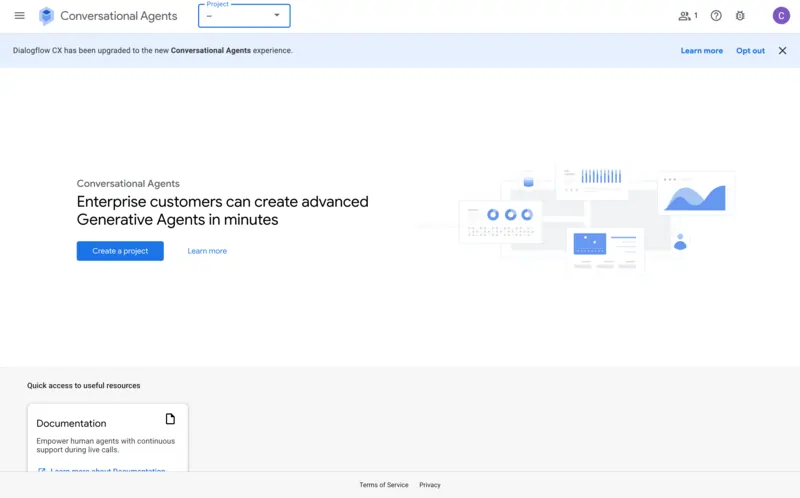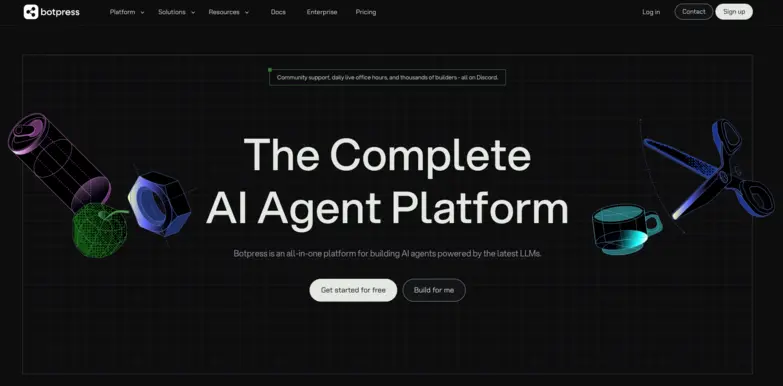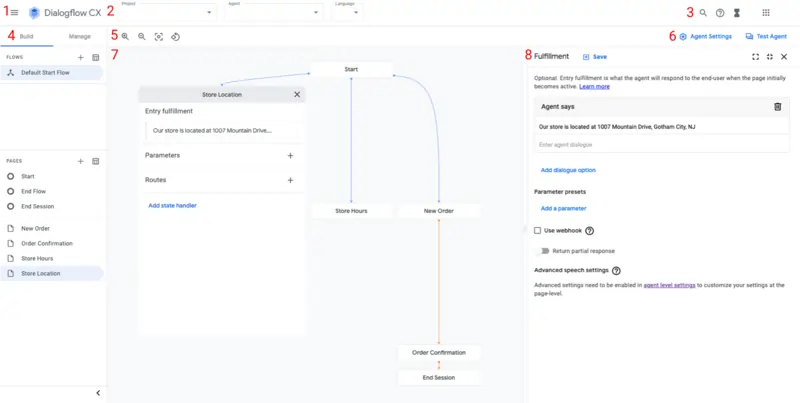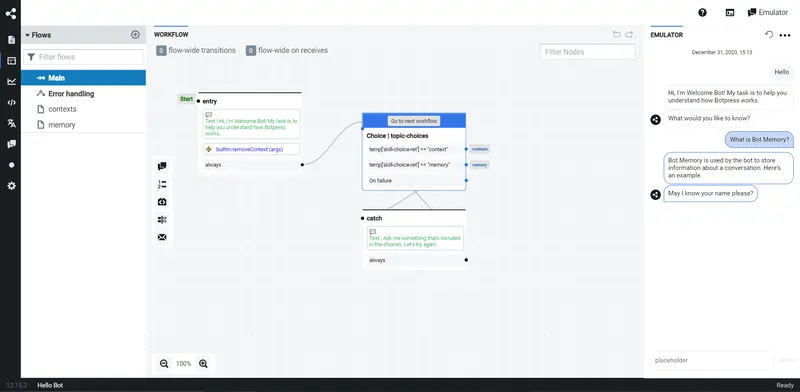The conversational AI space is evolving fast, with more platforms than ever claiming to be the right fit for modern businesses.
Whether you're launching an AI chatbot to handle support tickets or building a full-scale AI agent to automate internal workflows, choosing the right platform is critical – and confusing.
Dialogflow CX and Botpress are two leading options for teams building AI agents.
Curious how they compare? Let’s break down Dialogflow CX vs. Botpress.
Quick Overview: Dialogflow CX vs. Botpress
Dialogflow CX is Google’s advanced conversational AI platform for building virtual agents that manage complex conversations across text and voice channels. Using a visual, state-based flow system and natural language understanding, it turns user input into structured data.
Dialogflow CX supports web, mobile apps, interactive voice response systems, and smart devices, making it suitable for enterprise-grade bots that need to handle high-volume interactions. It also supports both text and synthetic speech responses.

Botpress is a conversational AI chatbot platform designed to create sophisticated AI agents. With features like in-house retrieval-augmented generation (RAG) and multi-turn memory, Botpress enables the creation of AI agents that not only automate support but can drive product recommendations, onboarding, internal workflows, and more – all while being fully customizable.

Feature-By-Feature Comparison
Dialogflow CX vs. Botpress Pricing Comparison
TL;DR: Dialogflow CX is a good fit for teams needing granular control within Google Cloud, while Botpress appeals to teams seeking scalable conversational AI with predictable pricing and full control over AI usage.
Dialogflow CX Pricing
Dialogflow CX uses a usage-based pricing model. They offer $600 in free credits for standard features and $1,000 for Generative AI features.
Pricing is based on request type (text or voice) and feature type (standard or generative AI):
- Standard text requests: $0.007 per request
- Text with Generative AI: $0.012 per request
- Audio input/output without Generative AI: $0.001 per second
- Audio input/output with Generative AI: $0.002 per second
- Generative AI storage: First 10 GiB/month free, then $5.00 per GiB/month
Botpress Pricing
Botpress offers a free plan that includes $5 in monthly AI credits. These AI credits act as a budget for powering smart features like knowledge retrieval and text rewriting in your bots.
Botpress also offers a Pay-As-You-Go option, which lets teams pay only for the AI usage they consume, making Botpress a cost-effective option for businesses.
In terms of paid plans, Botpress offers straightforward pricing tiers:
Integration Capabilities
TL;DR: Dialogflow CX offers native integrations within the Google ecosystem but relies heavily on webhooks and external setup for broader integrations. Botpress supports 190+ integrations out of the box and makes it easy to build custom connections without additional middleware.
Dialogflow CX provides 12+ native integrations, including popular messaging channels, as well as support for web chat via Dialogflow Messenger and voice via telephony/IVR. It also integrates well with other Google Cloud services and allows advanced developers to connect external systems via webhooks. However, broader integrations such as with CRMs, e-commerce platforms, or internal databases must be custom-built, often requiring middleware through platforms like Make or Zapier.
Botpress provides 190+ pre-built integrations across a wide range of tools like CRMs, help desks, e-commerce platforms, databases, and communication channels. These include native integrations with platforms like Salesforce, HubSpot, Zendesk, Shopify, and more, diversifying use cases like syncing customer data, updating records, triggering workflows, or automating ticketing. Developers can also build custom integrations easily using Botpress's built-in support for API calls, making it straightforward to connect with internal systems or third-party services without relying on external middleware.
Security Features
TL;DR: Dialogflow CX relies on Google Cloud for security setup. Botpress offers built-in enterprise security features.
Both Dialogflow CX and Botpress offer strong foundational security, but the source and scope of their features differ.
Dialogflow CX is powered by Google Cloud Platform. That means that Dialogflow CX’s security capabilities are managed at the Google Cloud project level, not directly within the Dialogflow CX console. Teams need to configure security settings through GCP’s Identity and Access Management (IAM).
Botpress includes a comprehensive set of security features directly within its platform. Botpress supports on-premise deployment, making it easier to meet strict compliance requirements like data residency laws. It also supports SSO integrations and encrypted memory handling, giving teams full control over how data is accessed and managed across the entire system.
Here’s how Dialogflow CX and Botpress’ security features compare:
Knowledge Capabilities
TL;DR: Dialogflow CX supports static knowledge access through its Generative AI features but has limited flexibility for live or structured data. Botpress offers advanced knowledge handling, connecting to real-time data and using smarter retrieval methods.
Dialogflow CX includes a feature called Data Stores (part of its Generative AI tools) that lets bots answer questions by pulling content from indexed sources like PDFs, web pages, or documents. However, Dialogflow CX doesn’t natively support connecting to live APIs, databases, or other structured data sources without using webhooks or external tools. It also offers limited control over how responses are ranked or combined from multiple sources, and all advanced retrieval features fall under Generative AI pricing.
Botpress uses a built-in retrieval-augmented generation engine that allows bots to search through both static and live data at runtime. Teams can upload documents, connect APIs, query databases, and use formats like JSON, CSV, and PDFs. The bot can then generate personalized responses based on the most relevant information it finds, rather than just pulling static answers. This makes it ideal for customer support, internal tools, or any case where the bot needs to reference up-to-date business data.
Customization & Flexibility
TL;DR: Botpress gives teams full control over bot behavior and integrations. Dialogflow CX relies heavily on external tools for advanced customization.
Dialogflow CX offers state-based conversation design, which makes it easier to design and manage structured conversations. This helps with building guided flows, but it also means customization depends on external services.
To add advanced logic in Dialogflow CX, teams must use webhooks connected to external tools like Google Cloud Functions or Firebase – there's no built-in scripting or native code editor. While it works well for structured flows, it lacks built-in scripting, reusable modules, and advanced customization tools. Chat UI customization is also limited, especially with Dialogflow Messenger.

Botpress, by contrast, is designed for full-stack customization. Developers can write and run custom code (JavaScript or TypeScript) directly in the platform, call APIs, and build complex workflows without leaving the environment.
Botpress supports reusable components, conditional logic, context-aware flows, and custom UI styling, making it easy to adapt to specific business processes or branding requirements. Additionally, teams can customize every layer, from message routing to NLP behavior to frontend widget appearance.

Memory Duration
TL;DR: Dialogflow CX does not have built-in memory across sessions. Botpress includes built-in memory that helps chatbots remember users and context over time.
Many chatbot platforms carry context during a single conversation, but only some can remember this context over time.
Dialogflow CX can store information during an active session but doesn’t offer persistent memory by default. This lets the bot carry context through multi-turn conversations. However, once the session ends (typically after 30 minutes of inactivity), that memory is lost. If a team wants the bot to remember user details between sessions, they need to set up an external database and use webhooks to fetch or store that data manually.
Botpress offers built-in session and long-term memory, allowing bots to remember details across user interactions automatically. Bots can track user history, preferences, and behavior, and personalize responses in future conversations. Developers control what gets stored, how long it’s retained, and how it’s used, without needing external tools or extra infrastructure.
Community & Support
TL;DR: Both Dialogflow CX and Botpress offer strong learning resources and documentation. Dialogflow CX relies on Google’s traditional support ecosystem, while Botpress adds a highly engaged developer community and hands-on support for all tiers.
At a baseline, Dialogflow CX and Botpress both provide robust learning resources, including documentation, tutorials, and product guides.
Dialogflow CX follows Google Cloud’s traditional support model. Developers can learn through platforms like Google Cloud Skills Boost, Codelabs, and YouTube tutorials, along with detailed official documentation. Support from Google experts is available through paid Google Cloud Support plans. For free users, help is mostly self-serve via forums like Stack Overflow and the Google Cloud Community, but these are not actively monitored by the Dialogflow product team.
Botpress offers a community-driven and hands-on support model tailored to teams building and scaling AI agents that includes:
- Live Chat Support available on Plus plans and above
- Max, the AI support bot, provides instant answers and in-platform guidance
- Customer Success Teams included with Team and Enterprise plans
- A 30,000+ member Discord server offers active peer support, product discussions, and daily live AMAs with Botpress engineers
While Dialogflow CX provides structured learning through Google’s vast ecosystem, Botpress combines real-time support with a community.
Which platform is better for my business?
1. 24/7 Multilingual Support for a Global Travel Company
Key Problem: Providing 24/7 multilingual support across channels for a global customer base.
Amir leads customer support at a global travel booking platform. His team deals with time-sensitive inquiries like flight changes, cancellations, and travel advisories – often in multiple languages and across channels like WhatsApp, mobile apps, and the company website. Amir needs:
- A chatbot that can understand and respond in multiple languages
- Consistent experience across all platforms
- Ability to access real-time booking data and perform actions like cancellations or itinerary changes
TL;DR: Dialogflow CX can handle multilingual queries and integrates with messaging apps, but Botpress offers stronger multilingual NLP and channel flexibility.
Dialogflow CX supports 30+ languages and enables language detection for delivering localized experiences. Amir can deploy his chatbot on WhatsApp, web, and IVR systems using built-in integrations and manage complex flows using visual, state-based conversation design. This helps his team handle multiple user journeys.
That being said, Dialogflow CX still lacks built-in long-term memory, so personalizing interactions across sessions requires external databases and webhook-based retrieval. While it integrates well with Google Cloud, adding real-time booking logic (like checking flight status or updating reservations) depends on building and managing that logic outside the platform. Dialogflow CX pricing can also increase quickly, especially with voice or Generative AI features enabled.
Botpress offers robust multilingual support (100+ languages) with control over localized content and NLU performance. It supports out-of-the-box integrations with web, WhatsApp, and custom channels, and allows Amir’s team to build flows that adapt based on language or booking status.
More importantly, Botpress bots can store user preferences and history between sessions, making it easier to offer personalized travel support without forcing users to repeat themselves. Botpress also offers predictable pricing tiers and a pay-as-you-go option, which makes it a more cost-effective solution for Amir.
Ultimately, if Amir’s team needs flexible multilingual support with backend automation and personalization, Botpress offers stronger capabilities.
2. Subscription SaaS Customer Support Scaling
Key Problem: A fast-growing SaaS company wants to deflect basic technical support and billing inquiries without hiring more agents.
Sam is the Head of Support at a rapidly growing B2B SaaS company. His team handles a flood of tickets related to login issues, billing confusion, and onboarding questions. To keep up without hiring more agents, Sam needs:
- A chatbot that can answer repetitive technical and billing questions
- Easy deployment within Zendesk and Intercom workflows
- Backend integration with CRM and billing systems like Stripe or HubSpot
TL;DR: Dialogflow CX enables structured FAQ bots and backend integration, but Botpress offers deeper customization, session memory, and built-in support for advanced workflows.
Dialogflow CX gives Sam the tools to build more structured support bots. The bot can be deployed across Slack, web, or Messenger and can connect to tools like Stripe or HubSpot through webhooks that call external services.
But Dialogflow CX still doesn't include built-in memory across sessions, so remembering a returning user or tracking ongoing support history requires setting up external storage and retrieval logic. While Dialogflow CX is powerful for handling structured support flows, more complex workflows or personalized follow-ups require more engineering effort and infrastructure management.
Botpress, on the other hand, supports persistent memory and visual flow logic. Sam can integrate the bot with Stripe APIs to let users check their billing status or update payment methods. With JavaScript-based custom nodes, Botpress allows for full backend integration and real-time logic, all while fitting neatly into helpdesk workflows. It can even tag conversations for agent review or follow up with automated onboarding reminders.
For a fast-moving SaaS company looking to automate support while retaining flexibility, Botpress provides a more scalable, integrated solution.
3. Automated Order Management for a D2C E-commerce Brand
Key Problem: Automating post-purchase support like tracking, returns, and product questions.
Priya leads CX at a D2C e-commerce brand that just expanded internationally. Her team handles thousands of queries about order tracking, returns, and product details every week. Priya needs:
- A chatbot that can guide customers through returns and track orders in real time
- Seamless integration into Shopify and web chat
- Support for automating repetitive tasks like refund requests or FAQs
TL;DR: Dialogflow CX supports structured conversation design and webhook-based automation, but Botpress provides stronger support for real-time data handling, memory, and complex workflows.
Dialogflow CX gives Priya a way to manage structured post-purchase flows using its visual flow builder. Her team can create flows for returns, shipping questions, and product FAQs, and connect to tools like Shopify via webhooks to fetch real-time tracking data or process return requests.
However, Dialogflow CX doesn’t include built-in long-term memory, so the bot can’t recall previous user preferences or product interactions across sessions without external storage. There’s also no built-in support for complex, multi-step workflows. For example, verifying return eligibility, updating an order, and sending a refund confirmation would require multiple external integrations and custom logic. Pricing is usage-based, which could become unpredictable during high-traffic periods like sales or holidays.
Botpress gives Priya and her bot more capabilities. The bot can look up orders via Shopify’s API, confirm delivery status, or walk users through the return process. With built-in memory, the bot can remember user preferences or product categories from previous chats. Plus, Botpress supports custom flows and natural-language filtering for navigating large product catalogs. Botpress also makes sense for Priya’s team cost-wise: predictable monthly pricing for usage, integrations, and multilingual support keeps things budget-friendly during peak seasons.
For post-purchase support with real-time updates and automation, Botpress is a more flexible and cost-effective choice.
4. Heavily Regulated Industry Support (Healthcare)
Key Problem: Automating inquiries while meeting strict compliance and audit needs.
Marcus is responsible for customer experience at a healthcare provider. His team wants to automate scheduling, policy questions, and coverage info while staying compliant with HIPAA and regional data laws. Marcus needs:
- A secure chatbot that protects patient data
- Full audit logs and access control
- Option to deploy on-premise for compliance with internal security policies
TL;DR: Dialogflow CX benefits from Google Cloud’s strong security and compliance capabilities, but Botpress offers more control with on-premise deployment, built-in auditability, and flexible access control.
Dialogflow CX runs on Google Cloud Platform, giving Marcus access to enterprise-grade security features including encryption at rest and in transit, IAM-based role control, audit logging, and data residency options. It supports HIPAA compliance with a signed Business Associate Agreement (BAA) and is covered under Google Cloud’s SOC 2 certifications. However, these capabilities are configured through GCP infrastructure, not directly within Dialogflow CX itself.
To meet his team’s needs – like appointment scheduling or patient record lookups – Marcus would need to build external logic via webhooks and store any patient-related data outside of Dialogflow. Persistent memory isn’t supported natively and would require connecting to a secure database.
Botpress, by contrast, includes audit logs, RBAC, and memory out of the box. Most importantly, Botpress can be deployed on-premise or in a private cloud, ensuring full control over sensitive data. Developers can build workflows like insurance eligibility checks or lab scheduling, while storing key details securely with encrypted memory.
In summary, for use cases requiring maximum security and deployment control, Botpress is better suited to meet enterprise compliance needs.
The Bottom Line: Botpress vs Dialogflow ES
Dialogflow CX is great for structured bots on Google Cloud, while Botpress is the better fit for custom, full-featured AI agents across industries and infrastructure types.
Dialogflow CX is designed for teams building structured, multi-turn conversational agents, especially within the Google Cloud ecosystem. Its visual flow builder and state-based design make it ideal for managing complex dialog trees.
Botpress is built for teams that want full control over their chatbot’s behavior and integrations. With built-in memory, workflow automation, and flexible pricing, Botpress is especially well-suited for companies scaling their support or building bots that go beyond basic Q&A.
FAQs
1. How steep is the learning curve for each platform for first-time builders?
The learning curve for Botpress is moderate. Non-technical users can start with its visual builder but developers will benefit most from its full-code flexibility. Dialogflow CX has a steeper curve due to its state machine architecture and dependence on Google Cloud configuration, which often requires familiarity with IAM, webhooks, and external tooling.
2. What are the storage limits for knowledge base files or documents on each platform?
Botpress allows file uploads (e.g., PDFs, CSVs, JSON) with a soft size limit of around 50MB per file in most use cases, and teams can scale storage via integrations or external sources. Dialogflow CX’s knowledge ingestion is tied to its Data Stores (part of Generative AI features), and while there’s no strict document size limit published, Google charges separately for generative storage after the first 10 GiB/month, making scale more expensive.
3. Which platform offers better support for voice-based assistants or IVR systems?
Dialogflow CX has better built-in support for voice applications and IVR systems, offering native telephony integrations (e.g., with Twilio, Vonage) and audio input/output via its Speech-to-Text and Text-to-Speech APIs. Botpress supports voice use cases but requires more manual setup using external STT/TTS APIs and connectors, making it less plug-and-play for voice-first applications.
4. How do these platforms handle version control or staging environments?
Botpress supports versioning through workspaces and Git-based workflows, allowing teams to manage different environments and roll back changes when needed. Dialogflow CX includes built-in versioning and environment deployment tools that let users test and publish flows to specific stages (e.g., test, production), but more complex DevOps often requires Google Cloud tooling and IAM configuration.
5. Which platform allows faster prototyping for internal stakeholders or testing?
Botpress allows faster prototyping thanks to its drag-and-drop builder, instant preview, and built-in testing tools in the Studio. Dialogflow CX requires more configuration upfront, especially for managing agents, intents, and flows. So while powerful, it takes longer to get a usable prototype up and running without developer help.
.webp)




.webp)

